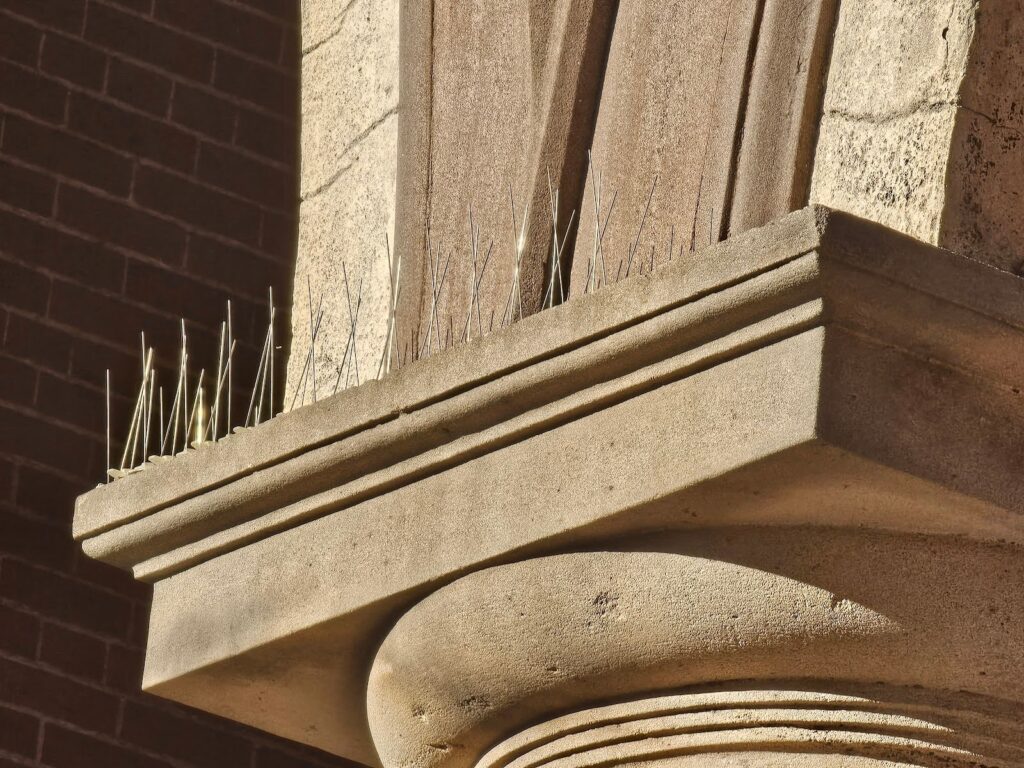Masonry Walls: Bird Spikes for Protection
This past week, we took a look at a masonry building assembly topped with large dangerous looking spikes that are intended to prevent birds from roosting and nesting on top of the wall. Bird poop and some of the diseases associated with bird feces and or the presence of birds might be a legitimate concern. This type of concern might apply equally to building managers and or residents of both residential homes and or commercial buildings.
As a side note, we used the word punish in the title of this article series. It might not be building owners’ intentions to actually punish birds, but in effect these spikes do that. It makes it harder for the birds to be comfortable in a place they would otherwise use to roost or rest as part of their natural migratory pattern.
The picture below shows the top of a masonry column. Thin, small pins and needle type spikes cover the top of that masonry column. As we discussed last week, some of the invasive species are problematic, but the spikes at the top of masonry walls, in general, deter larger birds more than smaller birds. The larger birds also generally cause the greater amount of problems. I sort of personally feel like this world belongs to the animals of nature as well as it does the humans.
We shouldn’t really do much to hurt animals. Simultaneously though, our company cares so much about the preservation of historic masonry. Therefore, we also understand why there is a balance and an importance to also preserve these buildings. They are architecturally valuable to us, both from a cultural perspective and from a perspective of social utility.

In general, ledges and projections away from the vertical faces of masonry facades, and or columns in this particular case, serve a purpose. They are both potential points of deterioration and also points of potential protection for the masonry below. Projecting elements provide a little bit of a cover. It could be pointed out that projections away from the facade of a building only protect from rain or precipitation that has no simultaneous or concurrent wind. While that concern is accurately important, it’s also worthwhile to note that there’s such a significant amount or proportion of rain or precipitation, in our area, without significant simultaneous wind, that these small projections can significantly help preserve the longevity of masonry facades.

The projecting ledge, at the top of the column, basically acts a little bit like a small roof or canopy to keep water off the surface of the masonry below. While the ledge will protect the surfaces below, it’s very helpful. However, the ledge also becomes a near horizontal surface for water to sit upon.
We specifically said near horizontal because most ledges are intentionally built to have a slight amount of cant or bevel. Both words basically mean the same thing but a cant is an old architectural term, used in Middle English in architectural instances to describe an intentional small amount of grade or angle to shed things like water in liquid form, away from a standing or sitting position on top of a ledge.
If the particular projecting ledge lacks sufficient angle. The water will, therein, deteriorate the surface and the subsurface structure of the masonry more rapidly. All of the elements of the deterioration that we are analyzing, for historic masonry, need to be analyzed in terms of time. None of these lead to immediate nor rapid deterioration. Instead, they lead to slow deterioration that could take place over many decades. The intended lifespan of a masonry building though, should be centuries, not months or years.

Projecting the ledges from the buildup of bird nesting debris is helpful because it leads to a higher amount of longevity for the substrate masonry. Let me look at the sub topics discussed within this week’s blog article and the previous week, on the similar aspects of the same topics, you can understand more both about the specific areas of animal meant and deterioration of masonry related to moisture permeation. The topics of moisture permeation sound different and unrelated to the more typical type of mitigation conducted through repointing of historic brickwork, but they’re actually very similar.
We can Help
Our company focuses on historic restoration more than modern building upkeep, maintenance, and construction, but our company understands both types of construction very well and a full picture well-rounded approach is needed in any niche in the construction industry. Although we focus on historic restoration, repointing, tuckpointing and historic brick repair, our company also has technical knowledge and competencies in the areas of modern and contemporary construction as well as we become one of the leaders in that area of the market today. Understanding both historic and modern or contemporary construction is useful because both aspects help understand the challenges and potential solutions for challenges in building science and construction.
We can help with a variety of historic masonry restoration needs and upkeep, from modest tuckpointing and or repointing to complicated and extensive historic masonry restoration. Infinity Design Solutions is a historic restoration specialist contractor specializing in both historic masonry restoration such as tuckpointing our repointing, and brick repair. If you have questions about the architectural details or facade of your historic building in Washington DC, reach out and say hello and if we can help we’ll be glad to assist you. You can email us or call us on the telephone at the following link: contact us here.
